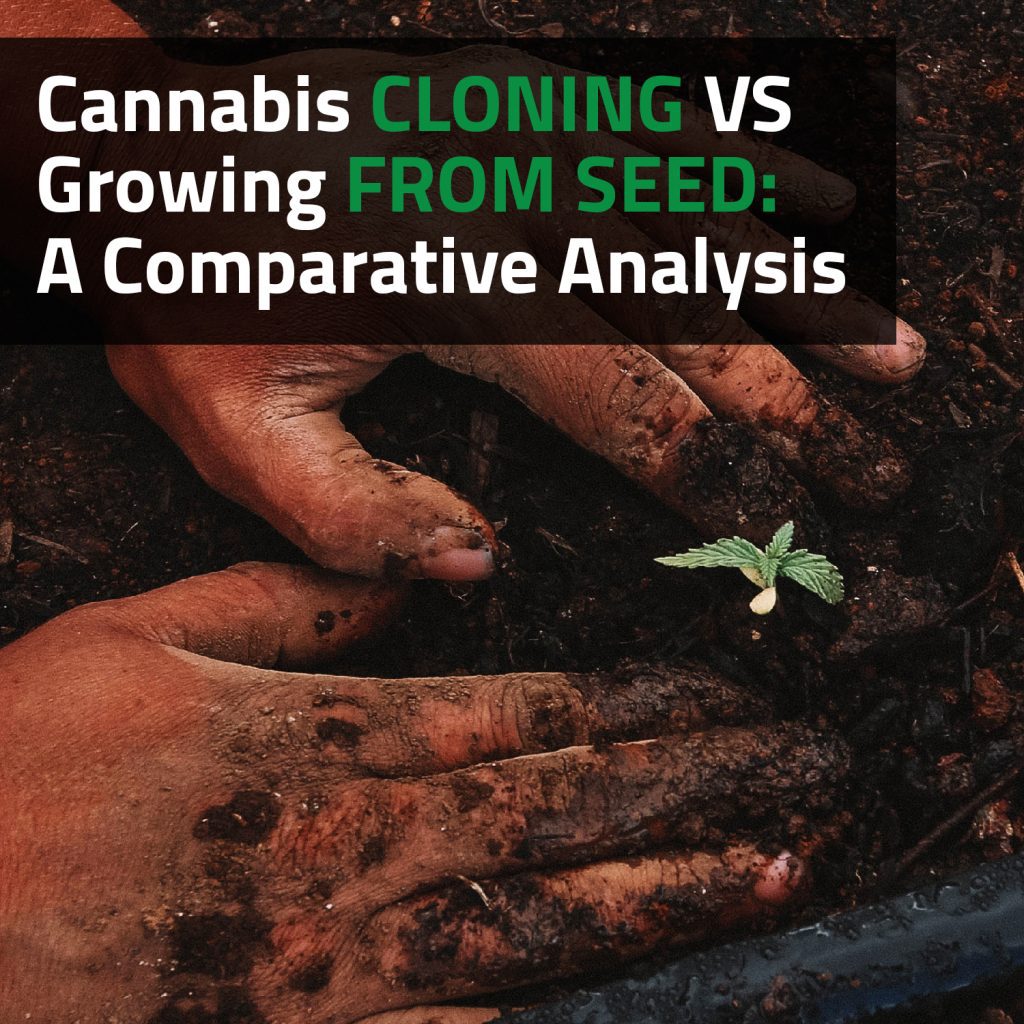Cultivating cannabis is an art that requires careful consideration of various factors, including the method of propagation. Two popular methods for growing cannabis plants are cloning and growing from seed. Each approach offers distinct advantages and challenges, making it essential for growers to understand the differences between the two. This article aims to provide a comprehensive comparative analysis of cannabis cloning and growing from seed, allowing cultivators to make informed decisions based on their specific needs and preferences.
By exploring the pros and cons of each method, including factors such as quality and yield, genetic stability, cost and time considerations, disease resistance, and legal implications, cultivators can gain insights into which approach aligns better with their cultivation goals and constraints. Whether you are an experienced grower looking to optimise your cultivation techniques or a novice considering the best method to start your cannabis garden, this comparative analysis aims to shed light on the nuances of cannabis cloning and growing from seed, empowering you to make smart choices along your cultivation journey.
The Basics Of Cannabis Cloning
Cannabis cloning is a propagation method that involves taking cuttings from a mature cannabis plant and rooting them to create new, genetically identical plants. This process allows growers to replicate desirable traits and characteristics from a successful mother plant, ensuring consistency in the resulting plants. Understanding the basics of cannabis cloning is essential for cultivators seeking to expand their cannabis garden or maintain a specific genetic profile.
To begin the cloning process, growers select a healthy, mature cannabis plant that exhibits the desired traits, such as high potency, specific flavour profile, or exceptional yield. The selected plant, known as the “mother plant,” should be free from pests, diseases, or any other issues that could be passed on to the clones.
Next, a cutting is taken from the mother plant. The cutting typically consists of a branch or stem with several nodes, which are the areas where leaves emerge. The cutting is typically 10 to 15
cm long and is cut at a 45-degree angle just below a node. It is crucial to use sterile tools and surfaces to minimise the risk of contamination and ensure successful rooting.
Once the cutting is obtained, any large fan leaves are typically trimmed to reduce moisture loss and focus the plant’s energy on root development. However, it is important to leave some smaller leaves intact, as they contribute to photosynthesis during the rooting process.
The cutting is then dipped into a rooting hormone, which stimulates root growth and increases the chances of successful rooting. The cutting is placed in a suitable rooting medium, such as a sterile soilless mix or a rockwool cube, where it will develop roots over time. The humidity and temperature should be carefully controlled to provide an optimal environment for root development.
During the rooting process, it is crucial to maintain adequate moisture levels without overwatering, as excessive moisture can lead to rotting. Growers often use humidity domes or propagation trays to create a humid environment that encourages root growth.
Once the roots have developed, the clone can be transplanted into a larger container or directly into the desired growing medium. It is important to monitor the clone carefully in the early stages to ensure it receives proper nutrition, light, and water.
Cannabis cloning offers several advantages to growers. It allows for the preservation and replication of desirable genetic traits, ensuring consistent quality and characteristics in the resulting plants. Clones also tend to mature faster than plants grown from seed, reducing overall cultivation time. Furthermore, by selecting clones from a proven mother plant, growers can have more confidence in the plants’ performance and outcomes.
The Process Of Growing Cannabis From Seed
Growing cannabis from seed is a popular method of propagation that offers cultivators the opportunity to explore genetic diversity, discover unique phenotypes, and develop their own strains. While it may require more time and effort compared to cloning, growing from seed can be a rewarding experience for both novice and experienced growers alike. Understanding the process of growing cannabis from seed is essential for cultivators looking to start their garden or expand their genetic library.
To begin the process, growers need to acquire high-quality cannabis seeds from a reputable source. Seeds can be obtained from seed banks, breeders, or even harvested from mature cannabis plants, depending on local regulations. It is important to select seeds from reputable sources to ensure genetic quality, viability, and reliability.
Once the seeds are obtained, growers must germinate them to initiate the growth process. There are various methods for germinating cannabis seeds, but the most common approach involves using a moist paper towel or cotton pads. The seeds are placed between the moistened material and kept in a warm and dark environment. Within a few days, the seeds will sprout, and the root, known as the taproot, will emerge.
Once the seeds have successfully germinated, they are ready to be planted. Growers can choose to plant the germinated seeds directly into their desired growing medium, or start them in small pots or seedling trays. The choice of medium can vary, ranging from soil to coco coir, rockwool, or hydroponic systems, depending on the grower’s preference and cultivation method.
Proper environmental conditions are crucial for the seedlings’ healthy growth. The young plants require sufficient light, typically provided by fluorescent lights or specialised grow lights, as well as the right temperature and humidity levels. The ideal temperature for seedlings is around 21-26 °C, with humidity levels around 60-70%. As the seedlings grow, they will require more light intensity and can be gradually transitioned to stronger light sources.
Watering the seedlings is important to ensure they receive adequate moisture without becoming waterlogged. Overwatering should be avoided, as it can lead to damping-off, root rot, and other issues. It is recommended to water the seedlings when the top layer of soil or growing medium feels dry to the touch. Additionally, growers can use gentle air circulation, such as fans, to strengthen the seedlings’ stems and promote healthy growth.
As the seedlings continue to grow, they will develop more leaves and nodes. At this stage, growers may choose to transplant them into larger containers or directly into their final growing medium. Transplanting should be done carefully to avoid damaging the delicate root system. It is important to ensure the new container or medium provides adequate drainage and nutrition to support the plants’ growth.
Throughout the vegetative and flowering stages, the plants require proper care, including regular watering, nutrient supplementation, and light cycle management. The vegetative stage involves providing 18–24 hours of light per day to encourage healthy foliage growth, while the flowering stage requires 12 hours of uninterrupted darkness to trigger the plants’ reproductive phase and bud development.
During the flowering stage, growers must closely monitor the plants for signs of nutrient deficiencies, pests, and diseases. Pruning and training techniques can be employed to manage the plants’ canopy and optimise light penetration and airflow.
The flowering phase lasts several weeks, depending on the strain and desired maturity level. As the buds develop and mature, growers must observe the trichomes’ colouration to determine the optimal time for harvest. Harvesting involves carefully cutting and drying the buds to preserve their potency, flavour, and aroma.
Growing cannabis from seed offers numerous advantages, including genetic diversity, the potential for discovering unique phenotypes, and the satisfaction of developing personalised strains. It allows growers to explore different genetic combinations and experiment with breeding projects. However, it also requires more time and patience compared to cloning, as the plants go through the germination and early growth stages.
Choosing The Right Method: Factors To Consider
When deciding between cannabis cloning and growing from seed, several factors should be taken into consideration to determine the method that best suits your cultivation goals and circumstances. Each method has its advantages and challenges, and understanding these factors will help you make an informed decision.
- Genetic stability and diversity: Cloning offers genetic stability, as the clones are exact replicas of the mother plant. This ensures consistency in traits and characteristics. On the other hand, growing from seed provides genetic diversity, allowing for the exploration of different phenotypes and the potential discovery of unique and desirable traits.
- Desired traits and phenotypes: Consider the specific traits you are looking for in your cannabis plants. Cloning allows you to preserve and replicate desirable traits from a successful mother plant, ensuring consistency in potency, flavour, and yield. Growing from seed offers the opportunity to explore a broader range of genetic combinations and potentially uncover exceptional phenotypes.
- Cultivation goals and time constraints: Cloning can be advantageous if you want to replicate a successful plant quickly and maintain a consistent crop. Clones tend to mature faster than plants grown from seed, reducing overall cultivation time. Growing from seed requires more time for germination and early growth stages but provides the opportunity for personalization and experimentation.
- Availability and legality of genetics: Consider the availability and legal regulations surrounding cannabis genetics in your region. Cloning may require access to a mother plant, which could be limited by legal restrictions or availability. Growing from seed offers a wider range of genetics that can be obtained from reputable seed banks or breeders.
- Disease and pest management: Clones can inherit any existing diseases or vulnerabilities from the mother plant, making disease and pest management crucial during the selection process. Growing from seed provides a fresh start and reduces the risk of inheriting pre-existing issues, although proper pest and disease prevention measures should still be implemented.
- Cost considerations: Cloning requires initial investments in cloning equipment, such as rooting hormones, propagation trays, and humidity domes. However, once a successful mother plant is established, the cost of propagation decreases. Growing from seed may require purchasing quality seeds but can be more cost-effective in the long run, especially if you plan to expand your genetic library.
- Skill level and experience: Consider your level of experience and comfort with different cultivation techniques. Cloning can be more challenging for beginners, as it requires precise techniques and attention to detail during the rooting process. Growing from seed offers a more straightforward starting point for novice growers.
- Personal preferences: Finally, consider your personal preferences as a grower. Some individuals enjoy the process of starting from seed, exploring genetic diversity, and participating in breeding projects. Others prefer the consistency and reliability of cloning, knowing they can replicate successful plants.
-
Black Leaf – Stainless Steel Screens
R5.00 -
Boveda Humidity Pack Sachet
R25.00 – R125.00 -
RAW – Rolling Machine
R55.00 – R75.00 -
Juicy Jay Hemp Wraps
R25.00
Ultimately, the right method depends on your specific goals, constraints, and preferences as a cultivator. Consider these factors carefully to make an informed decision that aligns with your cultivation style and desired outcomes. It is also worth noting that many growers combine both methods in their cultivation practices, utilising cannabis cloning for specific strains or maintaining a consistent crop while experimenting with seeds to explore new genetic possibilities.









